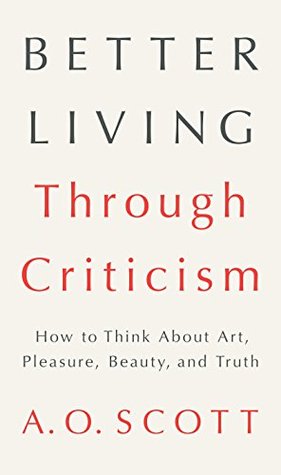More on this book
Community
Kindle Notes & Highlights
It is easier to seek out the comforts of groupthink, prejudice, and ignorance. Resisting those temptations requires vigilance, discipline, and curiosity.
It is my contention here that criticism, far from sapping the vitality of art, is instead what supplies its lifeblood; that criticism, properly understood, is not an enemy from which art must be defended, but rather another name—the proper name—for the defense of art itself.
All art that is recognizable as such is in some degree about other art. Every writer is a reader, every musician a listener, driven by a desire to imitate, to correct, to improve, or to answer the models before them. It would be too much to say that every artist is a failed critic, unable to appreciate what already exists without adding to it, but it does not seem to me inaccurate to say that all art is successful criticism.
So much of our striving—in love, religion, art, and work—seems to be undertaken out of a longing, overtly expressed or not, to restore a sense of lost wholeness. Once, just beyond the boundary of living memory or recorded history, we were complete. Now we are damaged, fallen, deformed.
For Shelley—and, before him, for Aeschylus—Prometheus was a hero, not a knave, and the emphasis falls not on his theft from the gods but on his gift to mankind. Art may still appropriate the divine prerogative of making, but it flatters by imitation rather than blaspheming by hubris.
Is art primarily the imitation of nature, driven by the desire to replicate what the eye sees in the world? Or does it always consist of the imitation of some other, prior art? Vasari’s answer is “both,” since nature itself is, quite literally and specifically, a work of art, fashioned of the same substances that later artists will use to capture it. The first creator worked in clay, stone, light, and color, and his followers will not only render what he made, but also reproduce it, on an appropriately modest scale, in similar media.
The latter was, for Rilke, the crucial undertaking of an aspiring poet. He saw the journey of the artist as, above all, an inward quest, involving less the mastery of technique or tradition than the relentless exploration of the soul. “Sir,” he wrote to Kappus in the first letter, “I can’t give you any advice but this: to go into yourself and see how deep the place is from which your life flows.”
Show me what’s on your iPod or your DVR or your bookshelves and I’ll tell you who you are. There’s no easier clairvoyance.
And it takes no effort at all to peg you, my friend, as a Gen-X baby in the throes of middle age, flailing between the Kubler-Ross stages of denial and acceptance as you mourn your lost youth. You grew up in the backwash of the baby boom, with educated parents who subscribed to the New Yorker and bought the well-reviewed novels of the day. Gore Vidal. Erica Jong. Watership Down. As for movies, you got to the 1960s New Waves and to ’70s New Hollywood a little too late: your touchstones were Saturday Night Fever and Star Wars rather than Mean Streets and Nashville. In many cases, you read the
...more
This highlight has been truncated due to consecutive passage length restrictions.
It also struck me as horribly unfair that, in the course of my lifetime, I would only ever get to occupy a single mind. I would only ever think and feel within the arbitrary limits of who I was. It would have been so much more interesting to be able to be a lot of different people in succession, and I was sorry not to have grown up in a religion with strong ideas about reincarnation or the transmigration of souls.
How are you supposed to choose, in the face of this abundance? What will guide your choices? There are really only two options: marketers, whose job is to sell—that is, to spin, to hype, to lie—and critics, whose job is to tell the truth.
The essential modesty and rigor of the scientific method is widely and cheaply travestied and willfully misunderstood. The work of scientists consists to some degree of trying, over and over, to prove themselves wrong. A hypothesis is only valid if it has been exposed to repeated attempts at falsification, and once it has it wears the deceptively humble name of theory.
But even as we drift into a state of antiscientific mock skepticism, we also worship idols of vulgar pseudoscientific empiricism. The opiate of the half-enlightened masses in the digital era is information, data, “the math”—impersonal, unarguable, but nonetheless mysterious numbers that promise to turn our messiest and most intractable problems into sudoku puzzles.


